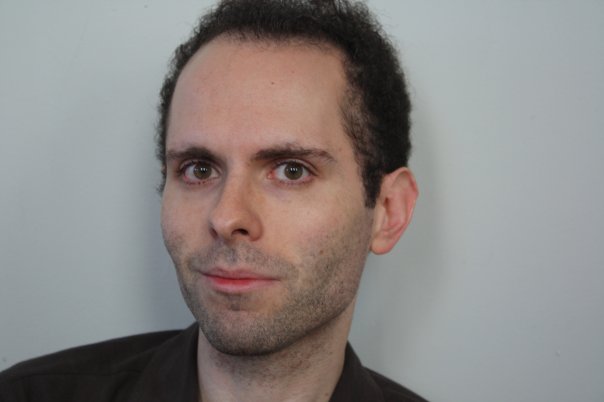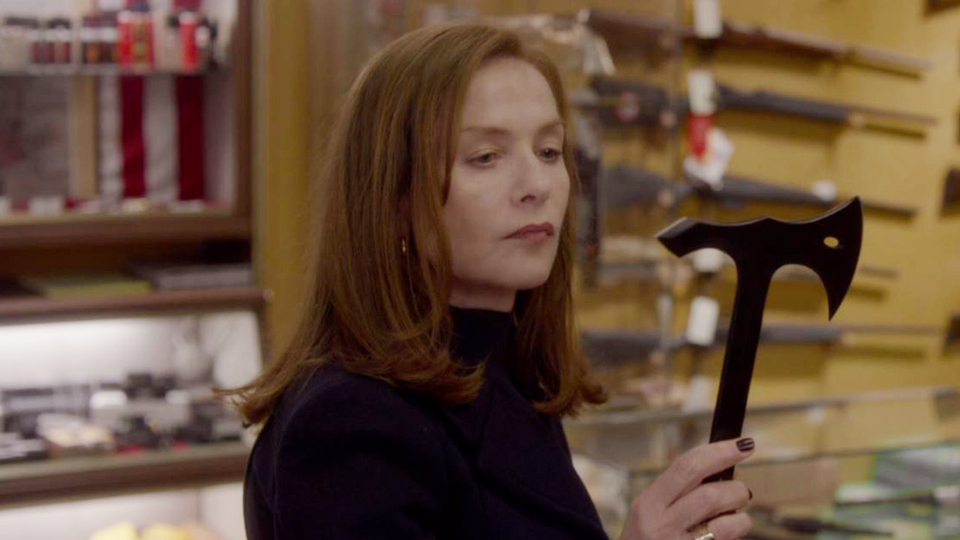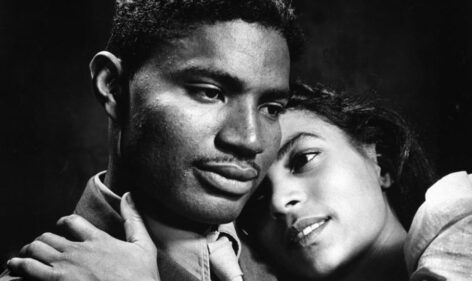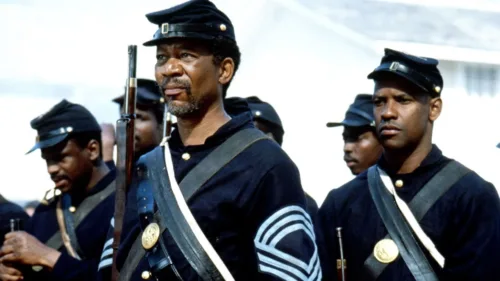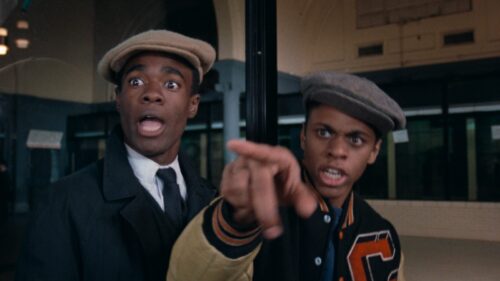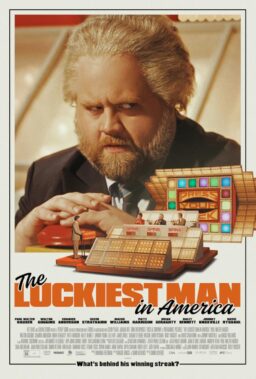The enigmatic French actress Isabelle Huppert has made over 100 feature films, and maybe her constant work rate over four and a half decades has partly necessitated her minimalist approach. Again and again the insolent Huppert presents the nearly blank canvas of her pale, watchful face to the camera, a face that is usually un-smiling and freckled and sullen and judgmental.
Huppert’s most notable characters have no moral or ethical boundaries, and she is a curious mixture of closed-off and helplessly present, always slightly squirming under the microscope of the camera, as if she is an alien sent to do research on earth and forever working inscrutable calculations in her head. She is wary and nihilistic, and she has become increasingly identified with perverse characters and extreme material, as in her latest film “Elle,” which is directed by Paul Verhoeven.
“Elle” is almost like a parody of an Isabelle Huppert movie where the game is in throwing as much trouble and difficulty at her as possible to see if that stone face of hers, that ubiquitous sourpuss emblem of art cinema in our time, will ever crack or show signs of strain. Huppert’s character in “Elle” is raped by a masked man in the first scene, but she barely reacts. Instead she collects herself, washes up, and rather half-heartedly tries to find out the identity of the rapist as she keeps on rolling with the punches from the rest of her busy life. Mentioning a photo of herself as a child in “Elle,” Huppert matter-of-factly offers, “My blank stare is terrifying.”
“Elle” isn’t really a drama or a thriller, and it only flirts with being a comedy. Instead, much like Catherine Breillat’s “Abuse of Weakness” (2013), this is a movie about just how unflappable and disturbingly bullheaded Huppert can be on screen. Her other major release of this year is Mia Hansen-Løve’s “Things to Come,” in which she is a philosophy professor dealing with a series of more conventional personal and professional setbacks. But her performance in “Things to Come” is anything but conventional: sharp, unpredictable, and unusually vulnerable. Always with Huppert on screen there is a sense that her stoicism needs to be tested.
Very little is known about Huppert’s off-screen life. She was born in 1953 to an English teacher mother and a safe manufacturer father, and she began acting very young and played a lot of small parts to begin with, like the girl who briefly has outdoors sex with the main male drifter characters in Bertrand Blier’s notorious “Going Places” (1974). She was one of the kidnaped debutantes in Otto Preminger’s “Rosebud” (1975), where she tried to seduce Peter O’Toole and first displayed her playful, un-self-conscious physicality. But it was something of a stretch when the round-faced, frowning young Huppert played the younger version of a character that turned into the diaphanous, enchanting Delphine Seyrig in “Aloïse” (1975). Sometimes it felt like Huppert was an intruder who had wandered onto the sets of her early movies just to look disapproving of them.
Her first major part was as a wallflower who has an unhappy love affair in “The Lacemaker” (1977), where she is a passive girl who is basically uncomfortable in her own body. Claude Chabrol saw how Huppert’s passivity could be creepy when he cast her as the murderous “Violette Nozière” (1978), where she is an empty vessel who lets herself be filled by immoral and finally evil impulses. Huppert made seven films in total with Chabrol, and so he is one of her key collaborators. They match up perfectly because his tone is also deadpan and scathing and almost comic, but not quite.

Huppert was pushed outside of her usual discomfort zone by Maurice Pialat in “Loulou” (1980, pictured above), where she was open to joy and laughter and drawn to and then repelled by Gérard Depardieu’s criminal-class sex beast. Her calm face absorbed all of the rhetoric and quotes thrown at her in two films for Jean-Luc Godard, “Every Man for Himself” (1980) and “Passion” (1982), and then she played a glowering sexpot for Joseph Losey in “The Trout” (1982), where she is sometimes overshadowed by the commanding Jeanne Moreau. As a young actress, Huppert willingly did nude scenes but always kept to her own stern and unyielding creative standards, even in the very openly sexual and vampy role she played in Bertrand Blier’s “My Best Friend’s Girl” (1983).
In 1982 Huppert married the director Ronald Chammah, and she has three children with him. Huppert is sometimes compared to Meryl Streep, but the only thing they seem to have in common is a long marriage with children and the fact that people don’t know too much about them. Streep is a maximalist with a supremely expressive face and she finds it very difficult to keep still on screen, whereas even when Huppert is at her most animated, as in Werner Schroeter’s relentlessly confrontational “Malina” (1991)—where she does one mad scene after another—it feels as if she is layering the animation on top of her own stony baseline manner. Streep barely touches on sexuality in any of her work, whereas Huppert in every era makes the exploration of sexuality feel like a duty, if not a compulsion.
Huppert has often found herself drawn into stories that are extremely unpleasant, like Paul Cox’s grueling “Cactus” (1986), where she played a girl who badly injures her eyes in a car accident. This is a film that would be unbearable with a more innately sympathetic actress in the lead, and yet it is close to unbearable even with the bone-dry Huppert at its center. When something bad happens to Huppert in a movie, she meets the misfortune with such harsh, formidable strength that she short-circuits our expected responses, so that after she has a stroke in “Abuse of Weakness” we don’t feel sorry for her as much as sorry for the stroke itself for having her as an opponent—the great thing about that Catherine Breillat movie is how semi-comic it is. Huppert asked for no sympathy as an abortionist in Chabrol’s “Story of Women” (1988) or as “Madame Bovary” (1991, pictured below), again for Chabrol, where her Emma Bovary is a very removed outcast.

Watch the scene where Huppert’s Emma Bovary goes to a ball and stares at the other couples dancing. In one exacting close-up, as her guarded eyes shift from one side of the room to another, Huppert lets us see that Emma knows that she will never be respectable enough to fit into this milieu. In a scene like this, it isn’t that Huppert doesn’t have an expressive face, like Streep does. It’s more that she is uninterested in being expressive and she is obstinately taking us the hard way through what could or should be easy emotions to display. This roundabout impulse of hers can be very alienating, but it can also lead us into areas of human behavior that have never been explored on screen before.
And so of course Huppert isn’t afraid of hard or difficult emotions and even welcomes them. She never asks for love or to be liked, but she sometimes does ask to be hated or feared. It is often said that Huppert is a “fearless” performer, but those of us who have seen some of her more obscure recent provocations like Christophe Honoré’s incestuous “Ma Mère” (2004) or the very offensive “My Little Princess” (2011) might wish that Huppert would cultivate a bit of fear. “My Little Princess” involves a mother who takes pornographic photos of her own very young daughter, and it is based on a true story that should only have been written about and not carelessly dramatized as a visual narrative. In that movie Huppert plays an odious woman in an aggressive and off-putting way, almost gloatingly.
But any objections to Huppert’s sensibility must fall away when countered by the achievement of her Erika Kohut in “The Piano Teacher” (2001, pictured below), her signature movie and the role of a lifetime. Who else but Huppert would have been able to sustain the full gamut of that woman’s sadism and masochism? Huppert stirs herself very deeply here, letting out a howl of pure pain when she tries to somehow make love to her own mother (Annie Girardot) and making herself totally naked emotionally when she abjectly offers herself up to a pretty boy student (Benoît Magimel) who has been pursuing her. This is a feast of a part for any actress brave enough to do it, but Erika Kohut is so damaged that she might seem incoherent if Huppert hadn’t shown us her fight against emotion with knife-cutting exactitude. “I have no feelings, get that into your head,” Erika tells her student lover. “If I ever do, they won’t defeat my intelligence.”
Huppert’s Erika Kohut is a tyrant as a piano teacher, yet she is so trapped in a relationship with her controlling mother at home that her only relief comes in acting out and becoming a dirty middle-aged woman in a raincoat who goes to porno shops and sniffs the used-up Kleenex from the floor. The really daring thing about Huppert’s performance in “The Piano Teacher” is how she shows us that Erika looks much happier staring at pornography than when she is listening to Schubert.

Erika is a cutter at home, methodically taking a razor to her own vagina as if she were simply trimming her toenails. And when she puts broken glass into the coat of a female student, Huppert makes us understand that this cruelty is actually a strand of Erika’s own self-loathing, as if she is punishing herself by disfiguring this poor insecure girl. What other actress could have played a scene like this and made you feel bad for the woman who is doing such an evil and destructive thing?
Huppert’s Erika Kohut smashes all existing norms and standards when it comes to what fresh hell can be shown or acted on screen. Huppert brings acting into new and perilous territories here, even if those new territories have sometimes led her astray in her subsequent work. Still and all, if you do something on the high level of Huppert’s performance in “The Piano Teacher,” you don’t need to do anything else. The only reaction possible to this performance, finally, is amazement at how far out she went with this role.
Not the least curious thing about Huppert is that she never seems to age. In fact, if you look at her in something like Hal Hartley’s “Amateur” (1994) when she was 40 and then “The Piano Teacher” and “Elle,” she actually seems to be aging in reverse, and without the aid of any obvious surgical intervention. She is in her early 60s now, but in “Elle” she is supposed to be 50 and looks it. This is all part of her alien quality, that thing that sets her apart. Most American actresses would kill for the range of leading parts that Huppert has secured in her forties, fifties, and sixties. If Huppert had been born an American, surely she would be an outcast by now or a player of small mother parts, but as a French icon she still gets to play a range of complex roles based around sexuality. (“After 40, women are fit for the trash,” she says gloomily in “Things to Come,” but that film and many of her others disprove this line.)
Just who is Huppert exactly? In interviews she reveals nothing of her personal life and very little about her working life, but she is a real cinephile who can analyze a filmmaker’s style in the most rigorous way. (She actually owns a cinema in Paris that is partly run by her son.) Huppert doesn’t like to rehearse or do a lot of takes, and she scorns obvious “acting.” She has worked with her share of major directors, but what is really impressive is the list of “of interest” auteurs she has worked with. As a French cinephile, Huppert is most interested in her director, not her role, which is one more thing that sets her far apart from Streep.
In between her three to five movies a year, which can run from experimental to outright cockamamie, Huppert relaxes by doing punishingly physical work in equally experimental theater. I saw Huppert on stage in Robert Wilson’s “Quartett” at the Brooklyn Academy of Music in 2009, and she was a commanding figure live, hurling out long speeches with estimable breath control and staring out at the audience with a blunt, glaring look that took no prisoners. This September at BAM she did “Phaedra(s)” and worked the stage like a virtuosic tyrant for three-and-a-half hours, moving from minimal to maximal and back again with inexhaustible appetite. At the curtain call, Huppert ran off the stage twice like an excited teenager, as if the excessive length and demands of this production had exhilarated her.
It is as if Huppert wants to exact some kind of price from us for watching her. And it also feels as if Huppert wants to be looked at but not seen when she acts, which is what she once said about her own work in an interview. Somehow Huppert calls to mind a remark made by the producer Samuel Goldwyn to director Billy Wilder: “Wilder, in life you have to take the bitter with the sour.”
